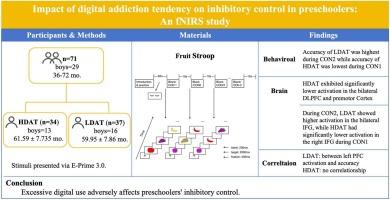Impact of digital addiction tendency on inhibitory control in preschoolers: An fNIRS study
IF 2.6
4区 医学
Q3 NEUROSCIENCES
引用次数: 0
Abstract
The increasing prevalence of digital devices in the lives of preschool-aged children raises concerns about their effects on early childhood development, particularly on inhibitory control, an essential cognitive function. This study investigates the relationship between digital addiction tendencies and inhibitory control using functional Near-Infrared Spectroscopy (fNIRS) to measure brain activation during a Fruit Stroop task. A sample of 71 typically developing preschoolers (29 boys, M age = 60.73, SD = 7.79 months) was recruited, with 34 participants categorized into the high digital addiction tendency (HDAT) group (13 boys, M age = 61.59, SD = 7.74 months) and 37 into the low digital addiction tendency (LDAT) group (16 boys, M age = 59.95, SD = 7.86 months). The findings revealed that (1) accuracy of LDAT was highest under inhibition conditions while accuracy of HDAT was lowest under neutral conditions; (2)children in HDAT group exhibited significantly lower activation in the bilateral dorsolateral prefrontal Cortex and premotor Cortex compared to their counterparts in LDAT; (3) during the inhibition task, the LDAT group demonstrated substantially higher activation in the bilateral inferior frontal gyrus, while the HDAT group showed significantly lower activation in the right inferior frontal gyrus during the neutral task; and (4) a correlation was found between left prefrontal cortex activation and accuracy in the LDAT group under neutral conditions, however, no correlation between brian activation and behavioral data was found in the HDAT. These results underscore the potential negative impacts of excessive digital use on preschoolers’ inhibitory control, providing valuable insights for educators and caregivers regarding digital consumption management for young children.

数字成瘾倾向对学龄前儿童抑制控制的影响:一项fNIRS研究。
数字设备在学龄前儿童生活中的日益普及引起了人们对其对儿童早期发展的影响的担忧,特别是对抑制控制(一种基本的认知功能)的影响。本研究利用功能性近红外光谱(fNIRS)测量水果Stroop任务时的大脑激活,探讨数字成瘾倾向与抑制控制之间的关系。样品71正常学龄前儿童(29岁男孩,M = 60.73岁SD = 7.79个月)招募,34个参与者分为高网瘾倾向(HDAT)组(13岁男孩,M = 61.59岁SD = 7.74个月),37到低网瘾倾向(LDAT)组(16岁男孩,M = 59.95岁SD = 7.86个月)。结果表明:(1)抑制条件下LDAT的准确度最高,中性条件下HDAT的准确度最低;(2)与LDAT组相比,HDAT组儿童双侧背外侧前额叶皮层和运动前皮层的激活显著降低;(3)在抑制任务中,LDAT组双侧额下回的激活显著提高,而HDAT组在中性任务中右侧额下回的激活显著降低;(4)中性条件下,LDAT组的左前额叶皮层激活与准确性之间存在相关性,而HDAT组的脑激活与行为数据之间没有相关性。这些结果强调了过度使用数字对学龄前儿童抑制控制的潜在负面影响,为教育工作者和照顾者提供了有关幼儿数字消费管理的宝贵见解。
本文章由计算机程序翻译,如有差异,请以英文原文为准。
求助全文
约1分钟内获得全文
求助全文
来源期刊

Brain Research
医学-神经科学
CiteScore
5.90
自引率
3.40%
发文量
268
审稿时长
47 days
期刊介绍:
An international multidisciplinary journal devoted to fundamental research in the brain sciences.
Brain Research publishes papers reporting interdisciplinary investigations of nervous system structure and function that are of general interest to the international community of neuroscientists. As is evident from the journals name, its scope is broad, ranging from cellular and molecular studies through systems neuroscience, cognition and disease. Invited reviews are also published; suggestions for and inquiries about potential reviews are welcomed.
With the appearance of the final issue of the 2011 subscription, Vol. 67/1-2 (24 June 2011), Brain Research Reviews has ceased publication as a distinct journal separate from Brain Research. Review articles accepted for Brain Research are now published in that journal.
 求助内容:
求助内容: 应助结果提醒方式:
应助结果提醒方式:


